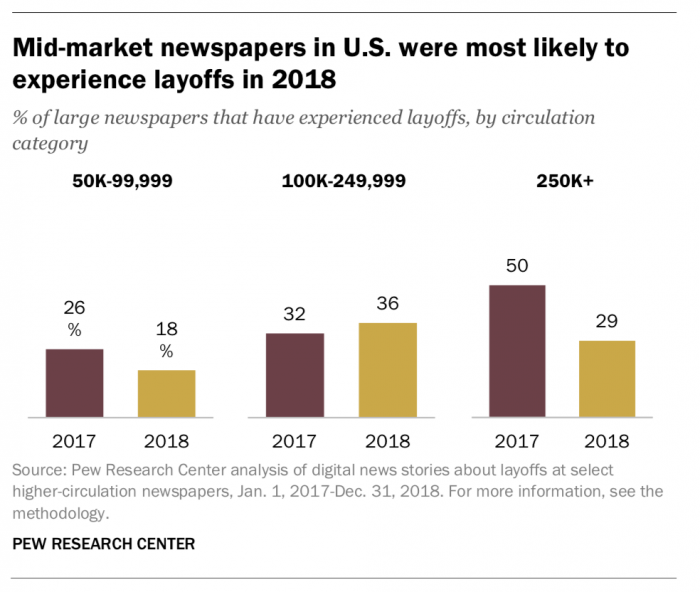If you work at a U.S. newspaper and didn’t have layoffs in the last two years, consider yourself lucky.
A new Pew Research Center analysis of articles about newspaper job cuts found that about a quarter of papers with Sunday circulation averaging 50,000 or more faced layoffs in 2018. That’s fewer papers than experienced this in 2017, but the papers in 2018 saw multiple rounds of layoffs.

The number of papers that could even cross the 50,000-circulation on Sundays threshold dropped from 110 to 97 from 2018 to 2017.

Pew’s Elizabeth Grieco explained the findings: “The specific papers with 50,000 or more Sunday circulation can vary year to year, but the vast majority (85 percent) fell into this category in both years included in this analysis. Of these, 9 percent had layoffs in 2017 and 2018. In other words, the papers that experienced staff losses in 2018 were for the most part different from those that did in 2017, widening the span of outlets with depleted staff.”
Buyouts were offered by 14 percent of newspapers in 2018, down a little from 18 percent in 2017. They were more likely to be offered at larger papers that could actually afford a few extra paychecks for reporters on their way out, rather than smaller-circulation papers that cut jobs outright.
The start of 2019 was marked with the gloom of layoffs at digital media sites, but Pew reminds us that 14 percent of high-traffic digital-native news organizations laid off staff in 2018 compared to about 20 percent in 2017. The digital media entries — deemed such by their “born on the web” status, original content production, and lack of user-generated or aggregated content (like Medium or Wikipedia) — increased from 35 in 2017 to 37 last year, adding HollywoodLife.com and 12up.com.
The full study is available here.
6 comments:
fxaytl
1cdhs8
jssi6e
thanzm
안성출장마사지
Greetings I am so glad I found your blog page, I really found you by mistake, while I was searching on Digg for something else, Nonetheless I am here now
and would just like to say cheers for a remarkable
post and a all round enjoyable blog (I also love the theme/design), I
don’t have time to read through it all at the minute but I have bookmarked it and also added
in your RSS feeds, so when I have time I will be back to read a great deal more, Please do keep up the superb job.
Trackbacks:
Leave a comment